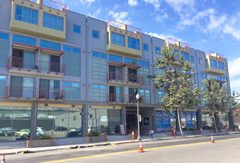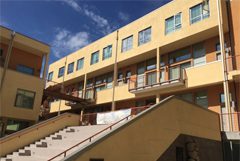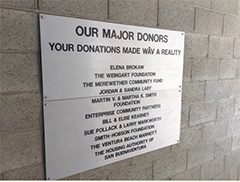A WAV Of Financial Trouble Traps Ventura

“When everybody owns something, nobody owns it, and nobody has a direct interest in maintaining or improving its condition. That is why buildings in the Soviet Union — like public housing in the United States — look decrepit within a year or two of their construction…”
—Milton Friedman, Nobel Peace Prize economist
THE WAV CONDOS – A FAILED PIPE DREAM
[The Proof is in the Pudding]
Our former City Manager, Rick Cole and former Mayor, Bill Fulton, sought to implement their visions for Ventura. They have moved on but they left the citizens of Ventura with financial problems.
Each arrived from the LA area with populist visions, advocating for a community with less cars, more public transportation, more public housing all driven by the concepts outlined by the New Urban Congress. Their visions were embraced by a vocal minority – the art community, architects and low income housing advocates and special interest builders and planners that could live off the Redevelopment Agency dole. Their visions were a financial disaster. Mr. Cole’s contract was not renewed. Mr. Fulton packed his suit case and moved to Washington. Most citizens “waved” goodbye. A few are still awaiting Mr. Fulton’s new book on how the New Urban experiment worked in the City of Ventura, particularly the 69 residents of this subsidized housing units in this project that has cost taxpayers $985,072 per living unit.
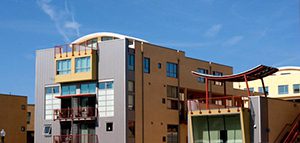
The WAV Condos. Ventura’s attempt to build an “arts” city.
In January 2012, we treated one aspect of this project – the 13 market rate condominiums and 6,100 sq.ft. of commercial space along Ventura Avenue at the corner of Thompson Boulevard. The sale of these units and the lease of the commercial spaces were supposed to provide a source for repayment of construction loans to CHASE and the City of Ventura.

Chase holds the note on Ventura’s WAV Condos. The city stands to lose $2.5 million if the WAV condos do not sell by 2016
To make the market rate condos and commercial space development work, the City loaned $2,000,000 to the developer ($2.5 million now due with interest), and subordinated that loan to a first trust deed in favor of CHASE in the sum of $4,000,000. Those loans were scheduled to be paid on the sale of the 13 condos, or by March 1, 2012. They did not sell and the commercial space did not lease. Facing foreclosure, and loss of our money, the City entered into a contract with CHASE to extend the due date to December 1, 2016.
This was not the result the City planned when this project was started. The City selected a person named Chris Velasco to “develop” the project, using our taxpayer dollars of course. Mr. Velasco signed the contracts, operating as a Minnesota non-profit company called PLACE. He gushed about the project. Here is one example:
“WAV’s market rate condominiums (priced from $625,000 to $875,000) are now for sale…WAV’s forward thinking configuration comes with an up market price tag. The average price per square foot for condominiums in the same zip code is $274; WAV’s pricing is $368 per square foot; however, buyers will be living green and helping underwrite WAV’s community. Besides the artists, and the public who flock to Ventura’s Art Walks and galleries, it includes those at 15 section 8 apartments”
So how reliable was the original plan? Not, by all accounts. The realtor involved with trying to sell the WAV units and lease the space recently shared his thoughts with us:
“These condos could only be sold for cash, or with a portfolio lender, due to Fannie Mae guidelines restricting the lending side. Its what I was up against for the three years. I had the listing together but was faced with the fact that the City refused to recognize that the condos were priced almost 1/3 higher than the market would bear. They would not entertain lowering them to market value.
“The condos were never worth $850K, at the most somewhere in the mid-$600s But even then the economy was turning down with buyers running for the hills. Add to THAT the fact they let my listing run out because I didn’t sell any. They said they wanted to take ‘another direction’.
“Now, perhaps they’re worth $479 tops – but you can’t use a traditional bank. Portfolio lender rates are usually at least 2 points higher, but a cash is the only way. Once one sale exists, there is a comp. Until then, its a big guessing game…”
—Jerry Breiner, Realtor
Editors Comment:
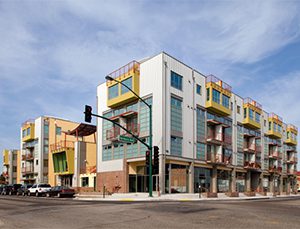
Dump the WAV Condos as fast as possible.
Our City stands to lose $2.5 million if the WAV condos do not sell by 2016. It is likely they will not sell. An objective person cannot avoid the obvious problem in marketing these condos — bad views (freeway), bad location, no parking, low income neighbors and bad design. Our goal should now be to sell them for what we can to avoid a potential total loss through the foreclosure process. In other words, forget the cheese and just get out of the trap.
BANKRUPTCY LOOMS FOR CITIES
[The Good, The Bad and The Ugly]
The election is over but the business prospects for California cities remains dismal. Moody’s, a business rating service has placed the debt of 30 California cities, under review for downgrade. With the rating downgrade each of these cities will have great difficulty in raising money to operate essential government functions by borrowing municipal bonds.
THE BAD
On the list for downgrade are Oakland, Fresno, Sacramento, Azusa, Berkeley, Colma, Danville, Downey, Fresno, Glendale, Huntington Beach, Inglewood, Long Beach, Los Gatos, Martinez ,Monterey, Oakland, Oceanside, Palmdale, Petaluma, Rancho Mirage, Redondo Beach, Sacramento, San Leandro, Santa Ana, Santa Barbara, Santa Clara, Santa Maria, Santa Monica, Santa Rosa, Sunnyvale, Torrance and Woodland.
The rating examinations will potentially affect $14.3 billion in lease-backed and general obligation debt on the books of these cities. Why? Because these cities did not address their internal cost structures, did not reduce personnel costs in the face of looming debt and used accounting gimmicks in the hopes that the economy would change. It has not changed. Add their unfunded pension and debt obligations to their itemized costs and they are in trouble.
THE UGLY
The cities of Vallejo, Stockton, San Bernardino and Mammoth Lakes filed for bankruptcy. Their revenues from real property taxes and sales taxes dropped precipitously while fixed costs, such as public safety pensions remained high. Public safety personnel refused to modify their benefits to help with the budget issues of their city. The fight between public safety unions, who refuse to modify their pension contracts, and the bond holders who loaned the cities money, looms large.
THE GOOD
At the beginning of the recession the City of Ventura lost $5 million when Washington Mutual (WAMU) collapsed and $5 million when Lehman tanked. Tax revenues plummeted from $100 million to $82 million currently (estimated). The City has tried to adjust for this 18% revenue reduction but the unfunded pension benefits for police and fire departments increased from $43,496,873 in 2008 to $68,385,380 in 2011. That is an increase of 57% for public safety. Add to that the $21,327,225 in unfunded benefits for all other City employees and we owe $89,712,605.
The positive news is that in the last four years is that the City has recovered $1.5 million of the WAMU investment. The City Council has also been trying hard to adjust their expenses and live within their means. Standard and Poor provided our City with a rating of AA.
One of the key individuals in achieving the S&P rating and urging fiscal restraint is our Chief Financial Officer, Jay Panzica. He has been instrumental in guiding the City through this difficult economic period. He was the driving force behind the Budgeting for Outcomes.
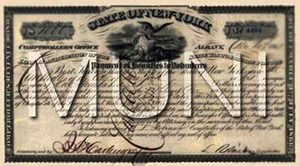
Chief Financial Officer, Jay Panzica, wasinstrumental in guiding the Ventura through this difficult economic period.
Mr. Panzica was also instrumental in setting the stage to help refinance the bonds owed for past water and waste water building projects. The first step was to seek an increase of water rates. This step, reviewed by a citizens committee in the fall of 2011, resulted in increased rates for all water users. The counsel prudently adopted those rates, on the recommendation of the citizens committee, thus setting the stage for a major refinance effort in 2012. Increased rate (revenue) by users provides the security for payment of the bond premiums in the future.
To take advantage of today’s lower interest rates, to refinance existing debt for Water and Wastewater projects and to obtain new money for new projects he asked our interim City Manager, Johnny Johnston, to seek approval from the City Council authorizing the issuance of $52 million in Water Revenue Bonds and $23 million in taxable Series A and tax-exempt Series B Waste Water bonds.
On October 8, 2012, the Council approved the request to:
- Refinance the existing water bonds ($27,410,000 issued in 2004)) and issue new bonds for additional $25,000,000 for future projects.
- Refinance the existing waste water bonds ($25,075,000 issued in 2004) for $23,000,000.
The bonds sold. As a result of a substantially reduced interest rate our City will save $1.8 million on the old water bonds and $2.3 million on the waste water bonds that we otherwise would have had to pay under the terms of the 2004 bond issue. A savings of $4.1 million plus financing costs, and another $25 million in new money for future water improvements is a very positive step forward.
Editors’ Comments:
Good is a relative concept. Creating a basis from which we can build infrastructure and thus create a solid foundation for future economic growth is the right course for government.
“If you put the Federal government in charge of the Sahara Desert in 5 years there’d be a shortage of Sand”
As for government trying to engage in business and compete with private enterprise the words of Milton Friedman says it all “If you put the Federal government in charge of the Sahara Desert in 5 years there’d be a shortage of Sand”
Editors:
B. Alviani K. Corse T. Cook
J. Tingstrom R. Mccord S. Doll
For more information like this, subscribe to our newsletter, Res Publica. Click here to enter your name and email address.


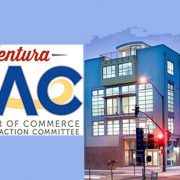

 The Political Action Committee (PAC) of the Ventura Chamber of Commerce will present a candidates forum to the citizens of Ventura, at the Marriott Beach Hotel, located at 2055 East Harbor Boulevard, Ventura, commencing at 7 P.M.
The Political Action Committee (PAC) of the Ventura Chamber of Commerce will present a candidates forum to the citizens of Ventura, at the Marriott Beach Hotel, located at 2055 East Harbor Boulevard, Ventura, commencing at 7 P.M.